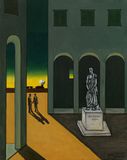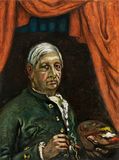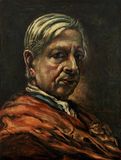
The Italian painter and graphic artist Giorgio de Chirico was born in Volvos, Greece, on July 7, 1888.
After attending the drawing class of the Polytechnic School in Athens he moves to Munich, where he studies at the Academy of Fine Arts from 1906 to 1909. Encountering works by Arnold Böcklin, Max Klinger and Alfred Kubin in Munich for the first time, leaves a great impression on him. Giorgio de Chirico also deals with music and the philosophical writings of Arthur Schopenhauer and especially of Friedrich Nietzsche.
In 1909 de Chririco goes to Italy, living in Milan, he visits Turin, Florence and other cities. He is in Paris from 1911 to 1915, participating in exhibitions in the Salon d'Automne and the Salon des Indépendants.Nietzsche’s strong influence is shown in his works in the choice of topics and the atmosphere of his paintings. Following the rules of perspective, George de Chirico paints realty combined with dream worlds, featuring ideal architecture and landscape views as well as the "Manichini" - faceless manikins.
In 1912 he makes the first paintings of the "Piazze d'Italia". In a military hospital in Ferrara he meets the painter Carlo Carrà in 1917, who decides to join him. Their expression of the basic theories of the "Pittura Metafisica" after the war, will be published by Chirico in form of articles for the magazine "Valori Plastici". In 1925 George de Chirico moves to Paris again and becomes a friend of the surrealist painters Max Ernst, René Magritte, Yves Tanguy and Salvador Dalí. Giorgio de Chirico also makes stage and costume designs, for instance for Sergej Diaghilew's "Ballets Russes". In 1929 he writes the autobiographic novel "Hebdomeros, Le peintre et son génie chez l'ecrivain". He executes numerous series of lithographs in the 1930s, he illustrates, for instance, the "Calligrammes" by Apollinaire in 1930, and Jean Cocteau's "Mythology" in 1934. As of 1937 he works on the series "Bagni Misteriosi". He stays in the USA from 1935 to 1937, then returns to Italy and finally settles in Rome in 1945.
Giorgio de Chirico's compositions became more conventional as of the late 1930s. He draw some of his earlier metaphysic works again, some of them he even dates back. The artist dies in Rome on November 11, 1978.
Giorgio de Chirico
Piazza d'Italia, 1970
Oil on canvas
50 x 40 cm 19 2/3 x 15 3/4 in.
Giorgio de Chirico
Autoritratto con tavolozza e tenda rossa, 1962-64
Oil on canvas
80.5 x 60 cm 31 5/8 x 23 5/8 in.
Giorgio de Chirico
Autoritratto con manto rosso, 1954-55
Oil on canvas
40 x 30 cm 15 3/4 x 11 3/4 in.
Giorgio de Chirico
Manichino stanco con rovine, 1927
Pencil and pen on paper
33 x 25 cm 13 x 9 5/6 in.



